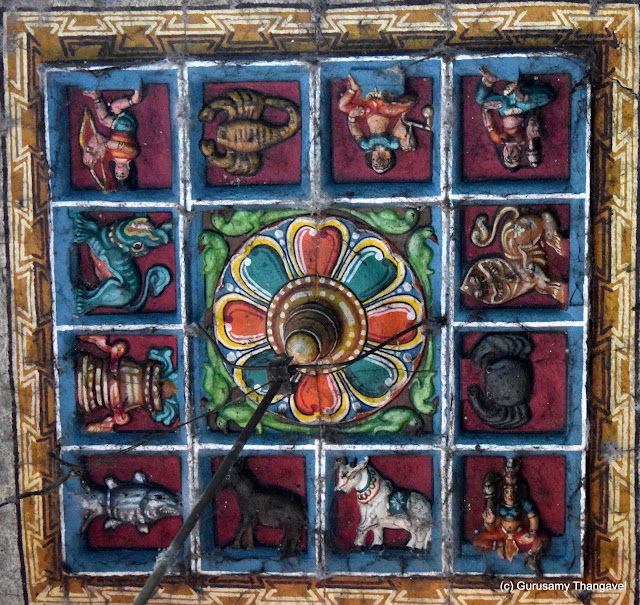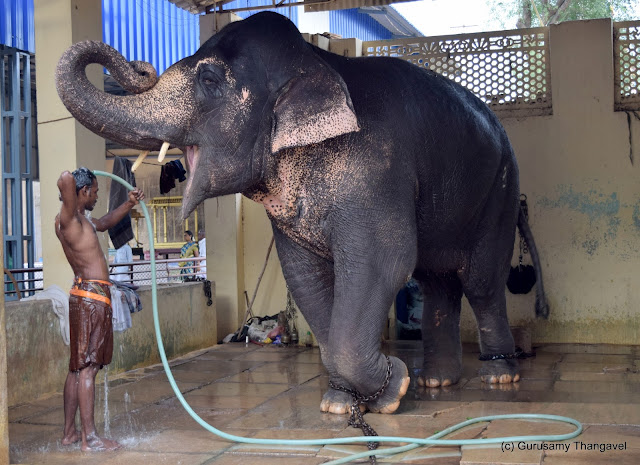I got up at 4.30 AM and reached the Devakottai bus stand around
5.15 AM. The next bus to Sivaganga was around 5.45 AM only. There was lot crowd
inside the bus stand owing to the marriage day. The bus to Sivaganga came fully
loaded; however, I got into the bus. Around 6.30 AM it reached Kalayarkoil. The
Kalayarkoil shiva temple can be easily spotted as soon as one gets out of the
bus as it is very near to the bus stand. There are two colorful temple towers,
which are very close to each other; the biggest of them is 150 ft tall. Both
Thirukoshtiyur and Kalayarkoil temples are maintained by the Sivaganga royal
family. It is a very ancient temple, praised by Nayanmars - the holy saints of
Saivism.
There are three sanctum sanctorums dedicated to Lord Shiva, a
unique one. There is a separate sanctum for his wife; called Swarnavalli amman.
The temple complex is huge. The magnificent high rise outer corridor with
granite pillars and flooring and colourful ceiling is typical of any ancient
Tamil Nadu temple. The temple has lot of openings with granite stones on the
roof to let the sunlight inside. The peeping sunlight, through these intricate
openings, makes a beautiful pattern. The modern skylights should feel shy in
front of this ancient technique. Wherever the skylight openings are there,
there is a dipping in the granite flooring with holes on the sides to navigate
the rain water. So there must me some form of rain water harvesting system
existed in the ancient temples. In addition to the skylights, there are lots of
ventilator openings close to the ceiling which function as the escape route for
hot air due to stack effect and thereby maintain the thermal comfort inside the
temple. I have taken photographs of these structures which can be utilized for
my classroom presentations on environmental ethics.
There were two marriages happening inside the temple. Kalayarkoil
is also associated with Maruthu pandiyar brothers who unsuccessfully fought
with the invading British during the late 18th century. They put up a proclamation against the British on the walls of Sri Rangam temple. One can
read the proclamation here. This was the first proclamation against the British - 56 years
before the first Indian mutiny, called the sepoy mutiny in 1857. If they had
won the war against the British, India’s history would have been different. But
history has lots of “ifs”, that’s why it is interesting to learn. When I was
leaving out of the Kalayarkoil temple, I saw the temple elephant trying to
capture the hose pipe, which was used by its mahout to take bath. The mahout
then put the hose inside the mouth of the elephant, which then cleverly used it
to take bath with its magnificent trunk. The scene was so beautiful and hence I
immediately captured it with my camera.
When I came out of the temple, it was almost 7.30 AM and I had to
reach Kalayarmangalam, a tiny village, where the marriage of my colleague’s (Dr.
Kannan) daughter was to be held by 8.10 AM. As I already had well searched the
location of the place by the use of Google maps, I had the confidence of
reaching it before the function. My neighbor in Chennai, a 75 yrs old man, is
actually from Kalayarkoil, had said that there are lots of taxis available in
Kalayarkoil. But I could not locate anything in the vicinity. May be because of
marriage day, they all would have been hired. Hence, I asked few of the locals
near there, but they scared me saying that I should either go to Karaikudi or
Sivaganga to reach that village. When I had reminded the street vegetable
vendor that there is a route between Nattarasankottai and Okkur and on that
route only the village is situated, he then told me that there is a town bus
now, which goes inside Nattarasnkottai and I can get down there and take an
auto to reach Kalayarmangalam. He also said it won’t take more than 15 minutes
to reach Nattarasankottai.
But I could not locate any town bus there in the bus stand. Hence,
I enquired with a flower vendor and he said there is no bus which can go inside
Natarasankottai now. He pointed out the two buses which were standing in the
bus stand, which are going to Sivaganga and told that I have to get down at
Nattarasankottai vilakku and to take an auto to reach the actual village. The
two buses, one government and a private, were standing idle without the
drivers. So I was really worried whether I would reach the spot before the
marriage function starts. However, as there were no alternatives available, I
got into the private bus as the government bus was not in good mode. My BP got
increased as the govt. bus started early. But within two minutes the private
bus driver also came in. When the bus had started to move, I asked the
conductor to give a ticket to Natarasankottai. But the conductor sensed it somehow
and said if you want to go the village then get into the bus which is coming
behind. I spotted the town bus and I immediately jumped from this moving bus.
In another 20 minutes I was in Nattarasankottai.
Nattarasankottai is also a small village but with rich history.
This is believed to be the first site of settlement of Nattukottai chettiyar’s
in the Pandya Kingdom. I saw two autos standing. The auto driver I approached
asked 250 rupees to take me to Kalayarmangalam. I knew it is barely few
kilometers away and the fellow is asking too much. I said I will give two
hundred rupees. He had agreed and when he turned the auto, I sighted a sign
board which indicated Kambar koil. I asked him how far the temple is. He said 2
kms and asked another hundred rupees to go there. I bargained it for 250 rupees
for both.
Kambar, the great poet of medieval Tamil (12th Century), recreated
Valmiki Ramayana in Tamil and it is called Kamba Ramayana. The great modern
Tamil poet Subramanya Bharathi once said that Kamban, Ilango and Thiruvalluvar
are the three poets who have no match for them as far as Tamil poetry is concerned.
Bharathi put Kambar in the first order, which says the importance of Kambar in
Tamil literature. Kambar Samadhi is a small shrine with a lot of greenery
around. There is a watchman and a priest. The priest told that Kambar had
attained Jeeva Samadhi here. Nattukottai chettiyars of this village are taking
care of it and he is the hereditary priest of this temple. He said the
government wants to take care of this monument, but the chettiyars are refusing
it to hand over. He gave me the prasadham, the sand, and told if you put this
prasadham in child’s mouth the child will learn easily. On the way I took
photos of Nagarathar’s houses at Nattarasankottai. I saw the famous Kannathal
temple also on the way to Kannan sir’s village. The village road was scenic.
Close to around 8.30 AM, I reached Kalayarmangalam.
The marriage was taking place inside his traditional house, which
looked small for Chettinadu’s standards. The house is full of his relatives,
most of them came from faraway places, as hardly these people live in their
villages. Only two or three houses in Kalyarmangalam are occupied by his
relatives and all other houses are vacant. The actual marriage took place
inside the pooja room where only five to six people can stand inside. After the
thirumangalyam (Mangal sutra) was tied the newly married couples were brought
to the hall where the other rituals were happening. There were two monitors to
live telecast the happenings inside the house and people were watching it by
sitting in the courtyards and corridors. I then called upon my other two
colleagues who were supposed to come from Chennai that day morning. They said
it would take another one hour for them to reach.
I befriended with a slightly elder person who was explaining me
the marriage process. Then I managed to enter inside the hall to take
photographs. My colleagues could only come in around 10.30 AM. We were then
taken inside the opposite house for refreshment, which belongs to Kannan sir’s
brother in law who is an auditor in Chennai. We started discussing with him and
soon we were joined by his co-brother, who is a HOD of ENT in Trichy government
medical college. In the whole function, we were the only three people who were
in modern dress, I mean with pant. All other people were in dhoti and easily we
were identified as outsiders. It was a pleasant site to see most of his
relatives came with their family and children and having a nice time in
chatting together. Some of them came from foreign countries. Around 11.30 AM we
were taken for the lunch. Needless to say the lunch was in Chettinadu style and
yummy.
Kannan sir wanted us to come back for the
reception in the evening around 5 PM in the bride groom’s place which is around
10 kms away. As I had already made up visiting Keezhadi, an excavation site,
and Madurai, I said I am leaving now. As both of my colleagues did not have
anything to do in between they agreed to accompany me up to Keezhadi. Keezhadi
is a recent excavation site close to Madurai which revealed the Sangam age (300
BCE to 200 CE) habitation. I will write about it and my Madurai visit in the
next and the last part of this travelogue series.














கருத்துகள் இல்லை:
கருத்துரையிடுக